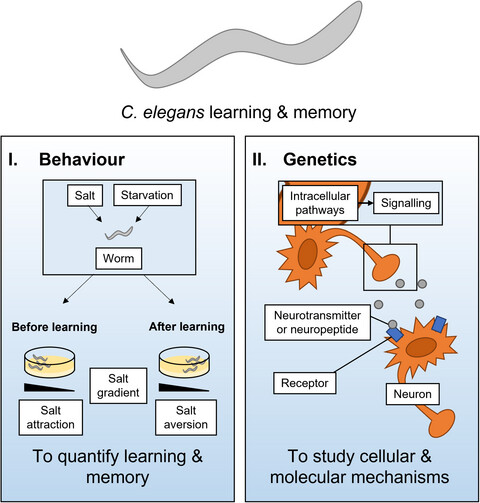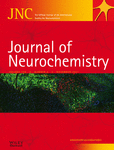Journal list menu
Export Citations
Download PDFs
Issue Information
Issue Information
- Pages: 403-413
- First Published: 25 October 2021

Front cover:
Visual information from the retina is transmitted to many brain regions including the lateral geniculate complex in the thalamus, which is divided into three functionally distinct nuclei: the dorsal lateral geniculate nucleus (dLGN), ventral LGN (vLGN), and intergeniculate leaflet (IGL). Despite being densely innervated by retinal input, our understanding of the cytoarchitecture and retinothalamic circuitry in the vLGN is significantly lacking compared to its dorsal counterpart. In this study, we used RNA sequencing, in situ hybridization, immunohistochemistry, and transgenic reporter mouse lines to identify novel subtypes of GABAergic neurons in the vLGN and map their spatial distribution. We found at least six GABAergic subtypes which organize into distinct adjoining adjoining sublaminae. Using trans-synaptic viral tracing and electrophysiological recordings, we found that these cells and layers receive monosynaptic inputs from the retina and differ in their morpho-electric properties in addition to their transcriptomes. Taken together, our findings are the first to suggest a neuroanatomical substrate for potential segregation of visual information in the vLGN into parallel channels and offer a toolkit to investigate the vLGN’s role in the rodent visual system.
Image Content:
This image of a horizontal section of the adult ventral lateral geniculate nucleus (vLGN) where transcriptionally distinct subsets of GABAeregic neurons reside in distinct sublaminae. Shown here is the organization of transgenically labeled Pvalb+ neurons (shown in green) and Ecel1+ neurons (shown in red), labeled by in situ hybridization, into sublaminae along the rostrocaudal axis. DAPI was used to label nuclei of all cells (shown in blue).
Read the full article ‘Diverse GABAergic neurons organize into subtype-specific sublaminae in the ventral lateral geniculate nucleus’ by U. Sabbagh, G. Govindaiah, R. D. Somaiya, R. V. Ha, J. C. Wei, W. Guido and M. A. Fox (J. Neurochem. 2021, vol. 159 (3), pp. 479–497) on doi:10.1111/jnc.15101
EDITORIAL HIGHLIGHT
Iron reduces the propagation of pathological α-synuclein: An Editorial Highlight for “Brain iron enrichment attenuates α-synuclein spreading after injection of preformed fibrils” on page 554.
- Pages: 414-416
- First Published: 23 July 2021

In the current issue of the Journal of Neurochemistry, Joppe et al. have found that the propagation of pathological α-synuclein caused by intrastriatal α-synuclein preformed fibrils (PFFs) injection was unexpectedly attenuated in rodent brains in a model of brain iron elevation (neonatal iron feeding). PFFs stimulated microglial activation was also reduced in mice with elevated iron. These results may provide new insight into the complex interaction between these two key pathologies of Parkinson's disease.
REVIEWS
Investigating the molecular mechanisms of learning and memory using Caenorhabditis elegans
- Pages: 417-451
- First Published: 16 September 2021

Caenorhabditis elegans provides a powerful system to study learning and memory, as it can be used for behavioural, cellular and genetic studies. This allows the quantification of learning through behaviour, as well as the exploration of learning mechanisms at the cellular and molecular levels. In this review, we summarise several behavioural paradigms in C. elegans that model associative or non-associative learning. In addition, we describe key molecular pathways that are proposed to mediate learning in C. elegans. Finally, we highlight the variability of these pathways in the context of specific paradigms, emphasising the complexity of C. elegans learning and memory.
Criss-crossing autism spectrum disorder and adult neurogenesis
- Pages: 452-478
- First Published: 03 September 2021

Autism spectrum disorder (ASD) comprises a group of neurodevelopmental disorders posing, in varying degree, a life-long challenge for both patients and caretakers. The impact of adult neurogenesis (AN) on the pathogenesis and development of ASD has not yet been fully cleared. We review the existing evidence of the molecular interplay between factors involved in the regulation of AN and the onset of ASD. The modulation of AN in ASD might lead to a better understanding and handling of ASD. Abbreviations: AN, adult neurogenesis; ASD, autism spectrum disorder; BDNF, brain-derived neurotrophic factor; IGF, insulin-like growth factor; NPC, neural progenitor cells; NSC, neural stem cells; SHH, sonic hedgehog; WNT, wingless-related integration site.
ORIGINAL ARTICLES
Brain Development & Cell Differentiation
Diverse GABAergic neurons organize into subtype-specific sublaminae in the ventral lateral geniculate nucleus
- Pages: 479-497
- First Published: 04 June 2020

The ventral lateral geniculate nucleus (vLGN) is part of the visual thalamus. It can broadly be separated into two structural domains or laminae, the external vLGNe (which receives retinal input) and the internal vLGNi (receives no retinal input). In this study, we describe subtypes of transcriptomically distinct GABAergic neurons that populate the vLGN and organize into discrete, adjacent sublaminae in the vLGNe. Taken together, our results show four subtype-specific sublaminae of retinorecipient neurons in vLGNe.
Akt3-mTOR regulates hippocampal neurogenesis in adult mouse
- Pages: 498-511
- First Published: 02 June 2021

Akt3 mutation in humans or Akt3 knockout in mice has been associated with cognitive defects. In this study, we observed that adult hippocampal stem cells and newborn neurons expressed the Akt3 protein. Akt3 deficiency caused down-regulation of mammalian target of rapamycin (mTOR) activity. Akt3 knockout or mTOR inhibition caused deficits in the proliferation of progenitor cells and neurite growth of newborn neurons, which were associated with decline in telomerase reverse transcriptase (TERT) expression, telomerase activity, and levels of p70 ribosomal protein S6 kinase (p70S6K) and eukaryotic translation initiation factor 4E-binding protein 1 (4EBP1) phosphorylation. The results indicate that Akt3-mTOR signaling is critical for adult hippocampal neurogenesis, which is required to maintain cognitive function.
Neuroinflammation & Neuroimmunology
Fragile X mental retardation protein-regulated proinflammatory cytokine expression in the spinal cord contributes to the pathogenesis of inflammatory pain induced by complete Freund's adjuvant
- Pages: 512-524
- First Published: 02 August 2021

Fragile X mental retardation protein (FMRP), an RNA-binding protein, plays a potential role in the pathogenesis of formalin- and (RS)-3,5-dihydroxyphenylglycine-induced abnormal pain sensations. However, the involvement of spinal FMRP in inflammatory pain has not been explored. Here, we show that FMRP was mainly expressed in spinal neurons and colocalized with tumor necrosis factor-α and interleukin-6. And FMRP contributes to inflammatory pain induced by complete Freund's adjuvant through the modulation of tumor necrosis factor-α and interleukin-6 expression in the spinal dorsal horn. These findings suggest that FMRP in the dorsal horn could be a potential therapeutic target for inflammatory pain.
Systemic inflammation induced the delayed reduction of excitatory synapses in the CA3 during ageing
- Pages: 525-542
- First Published: 11 August 2021

To simulate the cerebral dysfunction observed in patients with sepsis, we intraperitoneally injected lipopolysaccharide (LPS) into middle-aged (14–16 months old) mice and examined the cerebral effects in the survivors at 7 or 63 days post-injection (dpi). Our histological analysis demonstrated that LPS injection decreased the excitatory synapses in the CA3 hippocampal subfield with the inhibitory synapses remaining normal, suggesting the possible increase of the synaptic pruning between 7 dpi and 63 dpi. We also witnessed the reduction of synaptic pruning in the CA1 subfield. This likely indicates the associations with the diminished neuronal activity of the Schaffer collaterals.
A new brain-penetrant glucosylceramide synthase inhibitor as potential Therapeutics for Gaucher disease
- Pages: 543-553
- First Published: 16 August 2021

Suppression of glycosphingolipids accumulations by inhibition of glucosylceramide synthase (GCS) is considered a promising therapeutic approach for Gaucher disease. However, there is no effective treatment for the central nervous system symptoms today. Here, we report discovery of a novel GCS inhibitor T-036, which is potent, orally effective, and brain-penetrant. T-036 does not harbor an aliphatic amine moiety and has a non-competitive, inhibitory binding mode to the substrates unlike other known inhibitors. T-036 exhibited significant reduction of glycosphingolipids in the disease mouse model. Therefore, T-036 could be a promising lead molecule for treating central nervous system symptoms of GD.
Molecular Basis of Disease
Brain iron enrichment attenuates α-synuclein spreading after injection of preformed fibrils
- Pages: 554-573
- First Published: 27 June 2021

Brain iron accumulation and α-synuclein (α-syn) spreading pathology are common pathological findings in Parkinson's disease. To elucidate the influence of iron on α-syn propagation, we investigated α-syn spreading after stereotactic injection of α-syn preformed fibrils (PFFs) into the striatum of C57Bl/6 mice after neonatal brain iron enrichment. 90 days post-injection, PFFs injected mice displayed memory deficits, reduced α-syn pathology and spreading to connectome-specific regions after brain iron enrichment. Our study suggests that α-syn PFFs may induce cognitive deficits in mice independent of iron. However, a redistribution of α-syn pathology may be mediated via iron-induced alterations of the brain connectome.
Palmitate-mediated induction of neuropeptide Y expression occurs through intracellular metabolites and not direct exposure to proinflammatory cytokines
- Pages: 574-589
- First Published: 05 September 2021

A model of NPY neurons from the hypothalamus was used to determine the molecular events involved in the palmitate-mediated induction of NPY and proinflammatory cytokine expression. Palmitate metabolites can induce Npy expression, as well as cytokines, which in turn induce neuroinflammation. The individual subset of cytokines induced by palmitate, as determined by array analysis, do not directly induce Npy expression alone nor does co-culture with conditioned medium. These finding indicate that these two effects are not interrelated and the regulation of Npy gene expression is dependent upon the intracellular metabolism of palmitate to specific lipids, including ceramide and phospholipids.
Morphine-induced kinase activation and localization in the periaqueductal gray of male and female mice
- Pages: 590-602
- First Published: 09 September 2021

Morphine is a potent opioid analgesic with a high propensity for the development of antinociceptive tolerance. In both male and female mice, repeated administration of morphine (10 mg/kg, i.p.) produces behavioral adaptations that result in decreased antinociception on acute thermal pain tests. The descending pain modulatory system, in particular the ventrolateral periaqueductal gray, is impacted by repeated activation of the µ-opioid receptors (MOPr) by morphine. We show that chronic morphine treatment also results in neuronal adaptations, specifically the enhanced activation and differential subcellular localization of the kinases ERK 1/2, protein kinase-A (PKA), and protein kinase-C (PKC).
Suppression of amyloid-β secretion from neurons by cis-9, trans-11-octadecadienoic acid, an isomer of conjugated linoleic acid
- Pages: 603-617
- First Published: 11 August 2021

Cis-9, trans-11 conjugated linoleic acid (CLA) suppressed the generation of neurotoxic amyloid β (Aβ) of Alzheimer's disease. This could be due to the reduced colocalization of Aβ protein precursor (APP) and β-site APP-cleaving enzyme 1 (BACE1) in late endosome, where APP is subject to amyloidogenic cleavage by BACE1, along with their increased colocalization in early endosome. Incorporation of CLA into membrane phosphatidylcholine (PC) occurs, and the existing of CLA-PC in neuronal membrane can alter a membrane property into non-amyloidogenic state.
Clinical Studies, Biomakers & Imaging
Kappa free light chain index as a diagnostic biomarker in multiple sclerosis: A real-world investigation
- Pages: 618-628
- First Published: 03 September 2021

We investigated the sensitivity, specificity, and overall diagnostic accuracy of Kappa Free Light Chain (KFLC)-index in multiple sclerosis (MS). KFLC-index was prospectively determined as part of the diagnostic workup in patients with suspected MS (n = 327) between May 2013 and February 2020. We found that KFLC-index in MS diagnostics has methodological advantages compared to oligoclonal bands and is independent to subjective interpretation. We show that KFLC-index was influenced neither by disease-modifying therapy, nor by demographic factors or other inflammatory or degenerative processes in MS as determined by biomarkers in cerebrospinal fluid.
Serum beta-secretase 1 (BACE1) activity increases in patients with mild cognitive impairment
- Pages: 629-637
- First Published: 17 September 2021

Beta-secretase 1 (BACE1) plays a central role in the production of amyloid-β in Alzheimer disease. BACE1 increase in brain and serum is associated with the occurrence of AD. This change occurs already in mild cognitive impairment (MCI) patients. Therefore, we evaluated whether serum BACE1 activity increases in MCI patients and is associated with the progression from MCI to dementia. Or findings showed significantly increased serum BACE1 activity in MCI patients (both amnestic and non-amnestic) compared with Controls, and overall suggest that a dysregulation of this enzyme might be an early event primarily associated with neurodegeneration.





